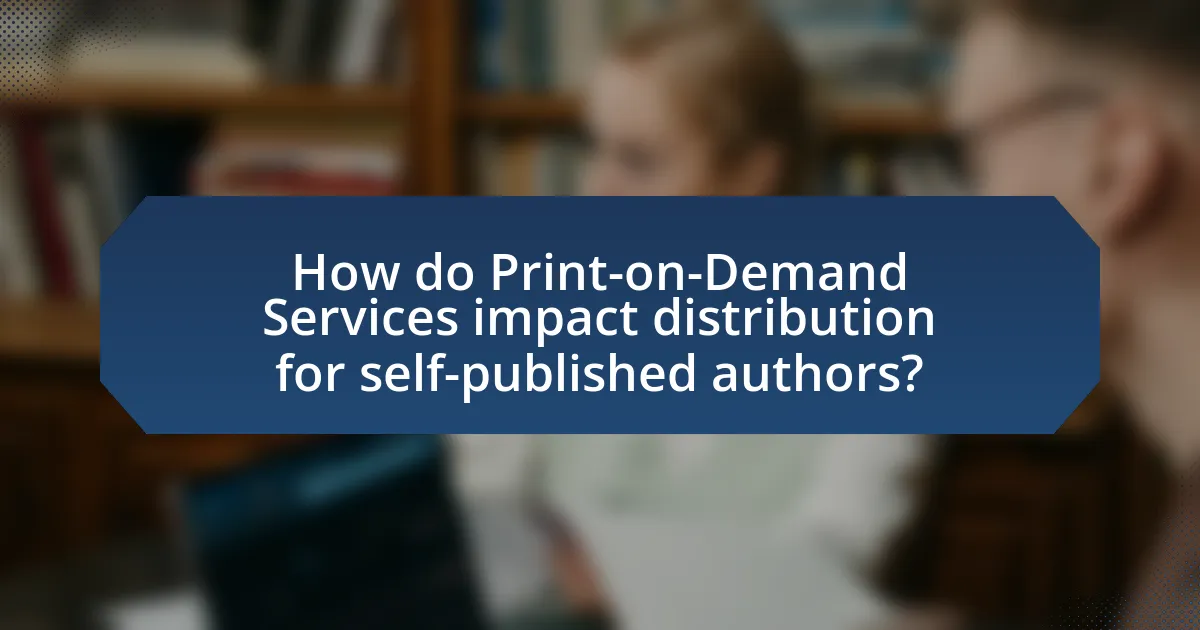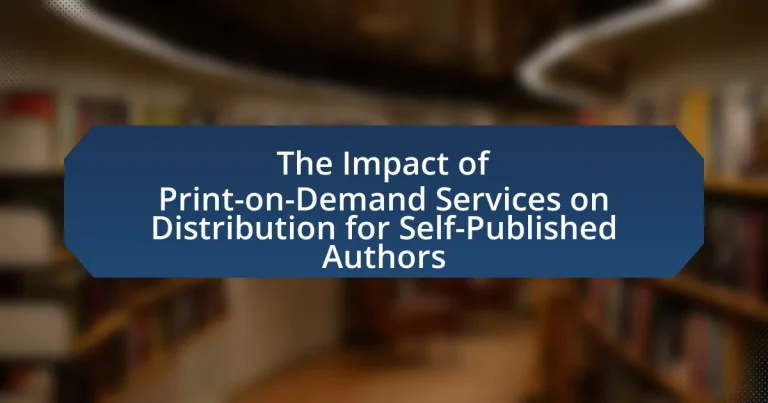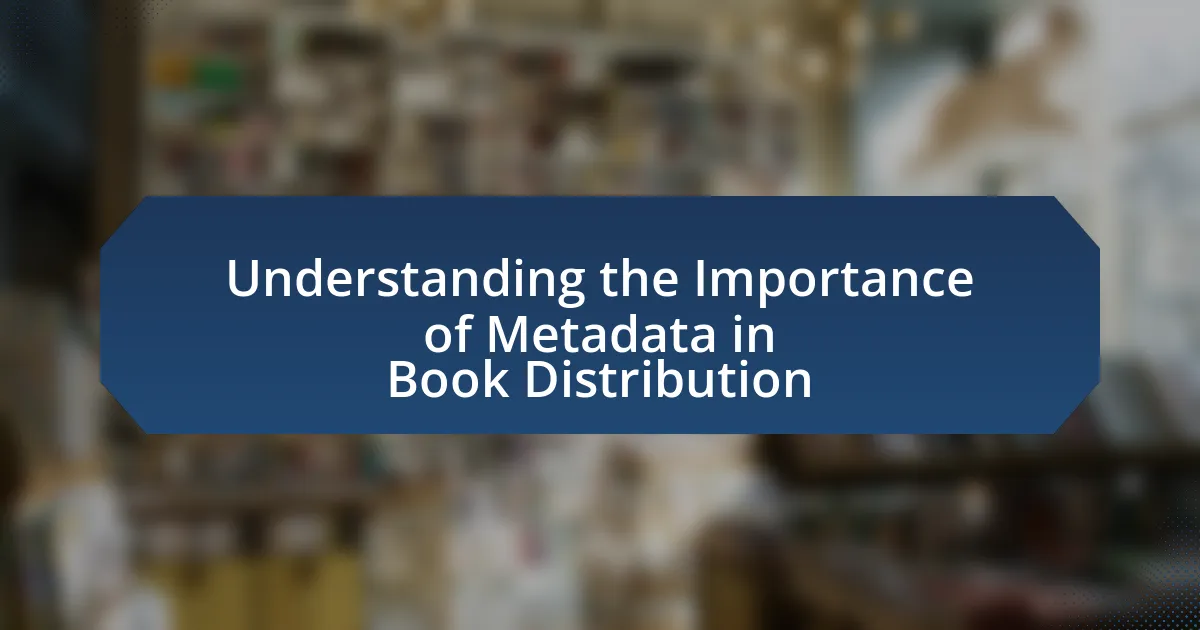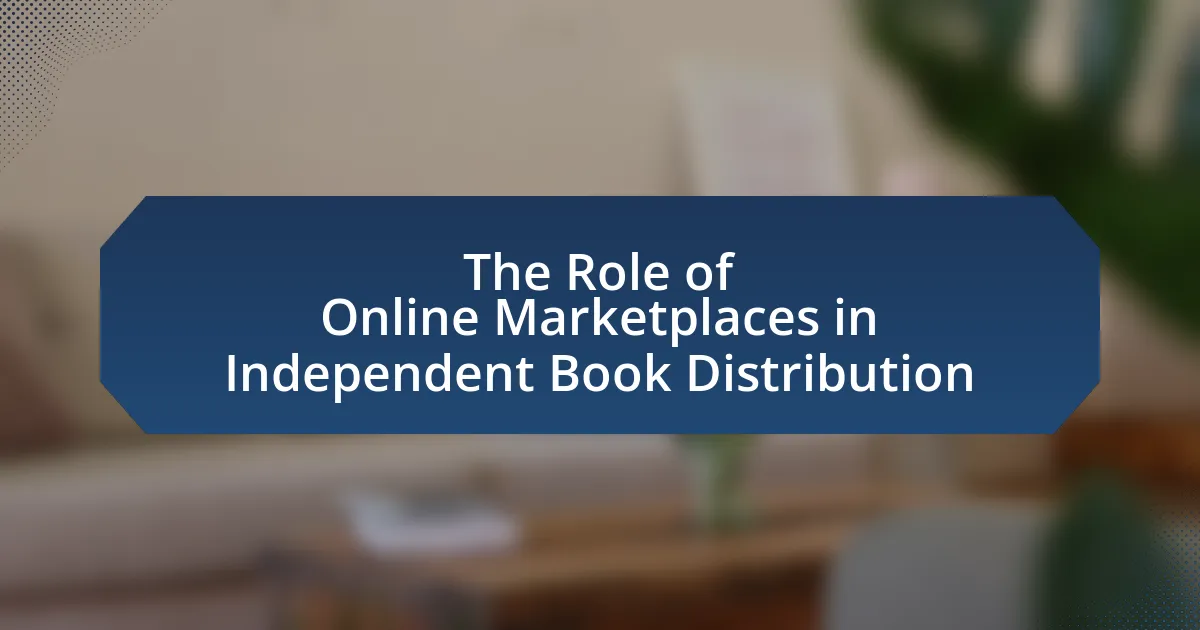Print-on-Demand (POD) services represent a transformative business model for self-published authors, allowing them to print books only upon receiving orders, thereby eliminating the need for large inventories and reducing upfront costs. This article explores the operational mechanisms of POD services, the technologies involved, and their impact on distribution channels, enabling authors to reach a global audience. It also addresses the advantages and challenges faced by self-published authors, including quality control, marketing strategies, and the implications for author royalties. By examining these aspects, the article highlights how POD services are reshaping the publishing landscape and providing new opportunities for authors to distribute their work effectively.

What are Print-on-Demand Services?
Print-on-Demand (POD) services are a business model that allows authors and creators to print books or products only when an order is placed, eliminating the need for large inventory. This model enables self-published authors to distribute their work without upfront printing costs, as they pay for printing only after a sale is made. According to a report by IBISWorld, the POD industry has grown significantly, with revenue reaching approximately $1 billion in the United States alone, highlighting its increasing relevance in the publishing landscape.
How do Print-on-Demand Services operate?
Print-on-Demand (POD) services operate by allowing authors and creators to print books or products only after an order is placed, eliminating the need for large inventory. When a customer places an order, the POD provider prints the item, packages it, and ships it directly to the customer, streamlining the distribution process. This model reduces upfront costs and risks for self-published authors, as they do not need to invest in bulk printing or storage. According to a report by IBISWorld, the POD industry has grown significantly, reflecting the increasing demand for customized products and the rise of self-publishing.
What technologies are involved in Print-on-Demand Services?
Print-on-Demand (POD) services utilize several key technologies, including digital printing, web-to-print platforms, and automated fulfillment systems. Digital printing technology allows for high-quality, on-demand production of books and other printed materials without the need for large print runs, making it cost-effective for self-published authors. Web-to-print platforms enable authors to upload their content, customize designs, and manage orders online, streamlining the publishing process. Automated fulfillment systems handle inventory management, order processing, and shipping, ensuring efficient delivery to customers. These technologies collectively enhance the accessibility and efficiency of distribution for self-published authors.
How do Print-on-Demand Services manage inventory and fulfillment?
Print-on-Demand (POD) services manage inventory and fulfillment by producing items only after an order is placed, eliminating the need for pre-stocking products. This model allows POD providers to maintain minimal inventory levels, as they print and ship products directly to customers upon request. For instance, companies like Printful and Teespring utilize automated systems that integrate with e-commerce platforms, ensuring seamless order processing and fulfillment. This approach not only reduces overhead costs associated with unsold inventory but also allows for a wide variety of customizable products, catering to diverse customer preferences without the risk of excess stock.
What advantages do Print-on-Demand Services provide for self-published authors?
Print-on-Demand (POD) services offer significant advantages for self-published authors, primarily by eliminating upfront printing costs and inventory management. This model allows authors to print books only when orders are placed, reducing financial risk and enabling them to focus on writing rather than logistics. Additionally, POD services provide global distribution through online platforms, increasing the potential reach of an author’s work without the need for traditional publishing contracts. According to a report by the Book Industry Study Group, the POD market has grown significantly, indicating a shift in how books are published and distributed, which supports the viability of self-publishing as a sustainable option for authors.
How do Print-on-Demand Services reduce upfront costs for authors?
Print-on-Demand (POD) services reduce upfront costs for authors by eliminating the need for large print runs and inventory storage. Authors can publish their books without significant financial investment, as POD allows them to print copies only when orders are placed. This model minimizes the risk of unsold inventory, which is a common financial burden in traditional publishing. According to a report by the Independent Book Publishers Association, authors using POD can save thousands of dollars that would otherwise be spent on printing and warehousing, making it a cost-effective solution for self-publishing.
What role do Print-on-Demand Services play in reaching a global audience?
Print-on-Demand (POD) services enable self-published authors to reach a global audience by allowing them to produce books only when ordered, eliminating the need for large upfront investments in inventory. This model facilitates international distribution through partnerships with global online retailers, such as Amazon and IngramSpark, which provide access to a vast customer base across multiple countries. Additionally, POD services often offer localized printing options, reducing shipping costs and delivery times for international customers. As a result, self-published authors can effectively market their works worldwide without the financial risks associated with traditional publishing methods.

How do Print-on-Demand Services impact distribution for self-published authors?
Print-on-Demand (POD) services significantly enhance distribution for self-published authors by allowing them to print books only as orders are received, eliminating the need for large upfront inventory costs. This model enables authors to reach a global audience through online platforms without the constraints of traditional publishing, which often requires extensive distribution networks. According to a report by the Independent Book Publishers Association, POD technology has democratized publishing, allowing authors to distribute their works through major retailers like Amazon and Barnes & Noble, thereby increasing their market reach. Additionally, POD services often provide authors with tools for marketing and sales tracking, further optimizing their distribution strategies.
What distribution channels are available through Print-on-Demand Services?
Print-on-Demand (POD) services offer several distribution channels, including online marketplaces, personal websites, and retail partnerships. Online marketplaces such as Amazon, Etsy, and eBay allow authors to reach a broad audience by listing their products directly on these platforms. Personal websites enable authors to sell directly to consumers, providing greater control over pricing and customer interaction. Retail partnerships with bookstores and other physical retailers can also be established, allowing authors to distribute their works in brick-and-mortar locations. These channels enhance visibility and accessibility for self-published authors, facilitating a more extensive reach in the market.
How do online marketplaces integrate with Print-on-Demand Services?
Online marketplaces integrate with Print-on-Demand (POD) services by utilizing APIs that facilitate seamless order processing and inventory management. These APIs allow marketplaces to automatically send customer orders to POD providers, who then print and ship products directly to consumers, eliminating the need for authors to hold inventory. For instance, platforms like Amazon and Etsy have established partnerships with POD services, enabling self-published authors to list their works without upfront costs while ensuring that each sale triggers a print order. This integration streamlines the distribution process, allowing authors to reach a broader audience efficiently while maintaining control over their content and pricing.
What are the implications of direct-to-consumer sales for authors?
Direct-to-consumer sales allow authors to retain a larger percentage of profits from book sales compared to traditional publishing models. This model eliminates intermediaries, enabling authors to sell directly through their websites or platforms, which can lead to increased revenue. For instance, authors can earn up to 70% of the sale price when selling e-books directly, compared to the 10-15% typically received from traditional publishers. Additionally, direct sales facilitate stronger relationships with readers, fostering a loyal customer base and enabling authors to gather valuable feedback and data on their audience. This approach also allows for greater control over marketing strategies and pricing, which can enhance an author’s visibility and adaptability in a competitive market.
How do Print-on-Demand Services affect the traditional publishing model?
Print-on-Demand (POD) services significantly disrupt the traditional publishing model by eliminating the need for large print runs and inventory storage. Traditional publishing relies on upfront investments in printing and distribution, which can lead to financial risk if books do not sell. In contrast, POD allows authors to print books as orders come in, reducing financial risk and enabling a more flexible publishing process. According to a 2021 report by the Book Industry Study Group, POD has grown by over 30% in the last five years, indicating a shift in consumer preferences towards on-demand products. This shift empowers self-published authors to enter the market without the barriers imposed by traditional publishers, thereby democratizing access to publishing and altering the competitive landscape.
What challenges do self-published authors face compared to traditional publishers?
Self-published authors face significant challenges compared to traditional publishers, primarily in areas such as marketing, distribution, and credibility. Unlike traditional publishers, who have established networks and resources for marketing and distribution, self-published authors often lack access to these channels, making it difficult to reach a wider audience. According to a 2021 survey by the Alliance of Independent Authors, 70% of self-published authors reported that marketing their books was their biggest challenge. Additionally, self-published works may struggle with perceived credibility, as traditional publishers often provide a level of vetting that enhances a book’s legitimacy. This perception can hinder sales and visibility in a competitive market.
How do Print-on-Demand Services influence author royalties and pricing?
Print-on-Demand (POD) services significantly influence author royalties and pricing by allowing authors to set their own prices while receiving a percentage of sales after production costs. Authors typically earn royalties ranging from 30% to 70% of the retail price, depending on the platform and pricing strategy they choose. For instance, if an author prices their book at $15 and the production cost is $5, they would earn $10 in royalties, which is 66.67% of the retail price. This model contrasts with traditional publishing, where authors often receive a fixed percentage of sales, typically lower than what POD offers. Additionally, POD services enable authors to adjust pricing dynamically based on market demand and competition, further impacting their potential earnings.

What are the challenges and limitations of Print-on-Demand Services for self-published authors?
Print-on-Demand (POD) services present several challenges and limitations for self-published authors, primarily including higher production costs, limited distribution options, and quality control issues. Higher production costs arise because POD services typically charge more per unit than traditional printing methods, which can reduce profit margins for authors. Limited distribution options exist as many POD services may not offer access to major retailers or international markets, restricting the potential audience. Quality control issues can occur since authors often have less oversight over the printing process, leading to inconsistencies in print quality and materials. These factors collectively hinder the effectiveness of POD services in maximizing the reach and profitability of self-published works.
What common issues do authors encounter with Print-on-Demand Services?
Authors commonly encounter issues such as quality control, pricing discrepancies, and distribution limitations with Print-on-Demand services. Quality control problems arise when the printed books do not meet the authors’ expectations in terms of print quality, binding, or color accuracy, which can lead to negative reviews and returns. Pricing discrepancies often occur due to varying production costs, which can affect the author’s profit margins and pricing strategies. Additionally, distribution limitations can restrict authors’ access to certain markets or retailers, impacting their overall reach and sales potential. These issues highlight the challenges authors face in ensuring their work is presented and sold effectively through Print-on-Demand platforms.
How can quality control be a concern for self-published authors?
Quality control is a significant concern for self-published authors because it directly affects the professionalism and marketability of their work. Self-published authors often lack the resources and expertise that traditional publishing houses provide, leading to potential issues such as poor editing, subpar cover design, and inconsistent formatting. According to a survey by the Alliance of Independent Authors, 70% of self-published authors reported that quality issues negatively impacted their sales and reader reviews. This highlights the necessity for self-published authors to invest in professional services to ensure their work meets industry standards, thereby enhancing their credibility and appeal in a competitive market.
What are the potential delays in production and shipping?
Potential delays in production and shipping for print-on-demand services include equipment malfunctions, supply chain disruptions, and increased order volumes. Equipment malfunctions can halt production, leading to extended timelines. Supply chain disruptions, such as shortages of raw materials or shipping delays, can further postpone delivery. Increased order volumes, especially during peak seasons, can overwhelm production capabilities, resulting in longer processing times. These factors collectively impact the efficiency of distribution for self-published authors relying on print-on-demand services.
How can authors effectively utilize Print-on-Demand Services?
Authors can effectively utilize Print-on-Demand (POD) services by leveraging their ability to print books as orders are placed, thus minimizing upfront costs and inventory risks. This model allows authors to publish their work without the need for large print runs, making it financially viable for self-published authors. Additionally, POD services often provide global distribution options, enabling authors to reach a wider audience through platforms like Amazon and IngramSpark. According to a 2021 report by the Independent Book Publishers Association, 70% of self-published authors reported using POD services to manage their distribution efficiently. This approach not only streamlines the publishing process but also allows authors to maintain control over pricing and royalties, enhancing their overall profitability.
What strategies can authors implement to maximize their reach?
Authors can maximize their reach by leveraging digital marketing strategies, utilizing social media platforms, and engaging in collaborations with other authors and influencers. Digital marketing allows authors to target specific audiences through paid advertisements and email campaigns, which can significantly increase visibility. Social media platforms, such as Instagram and Twitter, enable authors to connect directly with readers, share content, and promote their work effectively. Collaborations with other authors or influencers can expand an author’s audience by tapping into established follower bases, thereby enhancing reach. According to a study by the Pew Research Center, 72% of adults use social media, highlighting its potential as a powerful tool for authors to engage with a broad audience.
How can authors leverage marketing to enhance their Print-on-Demand sales?
Authors can leverage marketing to enhance their Print-on-Demand sales by utilizing targeted online advertising, social media engagement, and email marketing campaigns. Targeted online advertising, such as Facebook Ads or Google Ads, allows authors to reach specific demographics interested in their genre, increasing visibility and potential sales. Social media engagement helps build a community around the author’s brand, fostering relationships with readers and encouraging word-of-mouth promotion. Email marketing campaigns can effectively inform subscribers about new releases, special promotions, or exclusive content, driving traffic to sales platforms. According to a study by the Content Marketing Institute, 70% of consumers prefer to learn about products through content rather than traditional advertising, highlighting the effectiveness of these marketing strategies in boosting Print-on-Demand sales.
What best practices should self-published authors follow when using Print-on-Demand Services?
Self-published authors should prioritize quality, formatting, and marketing when using Print-on-Demand (POD) services. Ensuring high-quality cover design and interior formatting is crucial, as these elements significantly impact reader perception and sales. According to a study by the Alliance of Independent Authors, professionally designed covers can increase sales by up to 50%. Additionally, authors must choose a reputable POD provider that offers global distribution options, as this expands their market reach. Effective marketing strategies, including social media promotion and email newsletters, are essential for driving traffic to their POD listings. Furthermore, authors should regularly review sales data and customer feedback to refine their approach and improve future publications.





